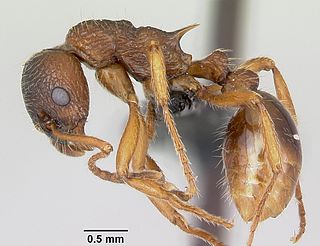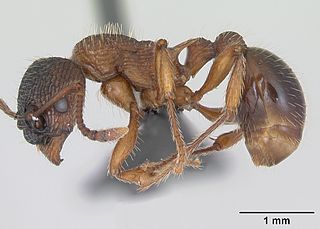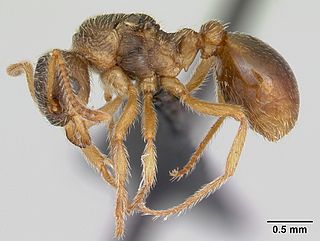
Formica exsecta is a species of ant found from Western Europe to Asia.

Myrmica rubra, also known as the common red ant or erroneously the European fire ant, is a species of ant of the genus Myrmica, found all over Europe and is now invasive in some parts of North America and Asia. It is mainly red in colour, with slightly darker pigmentation on the head. These ants live under stones and fallen trees, and in soil. They are aggressive, often attacking rather than running away, and are equipped with a stinger, though they lack the ability to spray formic acid like the genus Formica.

Myrmica is a genus of ants within the subfamily Myrmicinae. It is widespread throughout the temperate regions of the Holarctic and high mountains in Southeast Asia.

Phengaris rebeli, common name mountain Alcon blue, is a species of butterfly in the family Lycaenidae. It was first found and described in Styria, Austria, on Mount Hochschwab around 1700. Although it was initially classified as a subspecies of P. alcon, a European researcher, Lucien A. Berger, designated it as a separate species in 1946. Genetic similarities between P. rebeli and P. alcon have led many researchers to argue that the two are the same species and differences are due to intraspecific variation.

Pogonomyrmex occidentalis, or the western harvester ant, is a species of ant that inhabits the deserts and arid grasslands of the American West at or below 6,300 feet (1,900 m). Like other harvester ants in the genus Pogonomyrmex, it is so called because of its habit of collecting edible seeds and other food items. The specific epithet "occidentalis", meaning "of the west", refers to the fact that it is characteristic of the interior of the Western United States; its mounds of gravel, surrounded by areas denuded of plant life, are a conspicuous feature of rangeland. When numerous, they may cause such loss of grazing plants and seeds, as to constitute both a severe ecological and economic burden. They have a painful and venomous sting.

Myrmica ruginodis is a species of ant that lives in northern parts of Europe and Asia. It is very similar to M. rubra, but has a more northerly and higher-altitude distribution. Overwintering larvae may become either workers or queen ants, with up to 20 queens living in a colony of up to 2,500 individuals. Two subspecies are recognised, differing in the relative size of the queen.

Myrmica scabrinodis is a Euro-Siberian species of ant. It lives in moderately humid habitats, tolerates soil moisture but also needs direct sunshine. It often inhabits peat bogs. It builds nests in the ground, in grass or moss tussocks, even under stones or in rotten wood. Its colonies are monogynous or have only a few queens and may contain about 2500 workers. This ant species is the main host of the entomopathogenic fungus Rickia wasmannii. Phengaris caterpillars are primary threats of M. scabrinodis with specific species such as Phengaris arion developing a predatory relationship.

Dinoponera is a strictly South American genus of ant in the subfamily Ponerinae, commonly called tocandiras or giant Amazonian ants. These ants are generally less well known than Paraponera clavata, the bullet ant, yet Dinoponera females may surpass 3–4 cm (1.2–1.6 in) in total body length, making them among the largest ants in the world.

Myrmica lonae is a species of ant distributed across South, Central and North Europe, East Europe, Asia Minor, the Caucasus, West Siberian Plain and Northern Kazakhstan. It inhabits humid meadows both in the plains and in the mountains. It nests in the ground, under stones, or in moss. It forms polygynous colonies with up to 1000 workers or more.

Myrmica schencki is a species of ant in the genus Myrmica.

Myrmica gallienii is an ant species distributed from Central Europe to West Siberia. Also found in Sweden, Finland, Hungary, Bulgaria and Romania. It lives in wet grasslands and swamps, often in saline land. It builds shallow nests with a soil mound in moist habitats but deep nests in sandy areas. Colonies are relatively large with thousands of individuals.

Myrmica karavajevi is a workerless, socially parasitic ant species: it is widely distributed across Europe. It lives in nests of other species that inhabit warm and humid habitats.

Myrmica lobicornis is an ant species distributed through the planes of North Europe and the mountains of Central and Southern Europe. It is also found in the forest zone of East Europe, the Caucasus, West Siberia, North-East Kazakhstan, East Siberia, and Mongolia stretching until Transbaikalia in the East. It inhabits coniferous or mixed woodlands, occasionally also meadows. It mostly nests in the ground, forms monogynous colonies containing a few hundred workers.

Rickia wasmannii is a species of the widely distributed entomoparasitic order of fungi Laboulbeniales. It is an obligatory ectoparasite of ants of the genus Myrmica. The thalli penetrate outer layer of the cuticle, and appear on the host body surface. Little is known about its effect on the host ant, but it is usually regarded as a rather neutral symbiont. Contrarily, however, a recent study has documented an increased need of drinking water and a shortened life-span of infected ants.

Myrmica salina is a species of ant belonging to the genus Myrmica. They have a wide distribution in Europe and Siberia, as well as being abundant to several former republics of the Soviet Union, where their preferred habitats are relatively wet halophyte biotopes. Ruzsky first described the first specimen of the species in 1905.

Symphiles are insects which live as welcome guests in the nest of a social insect by which they are fed and guarded. The relationship between the symphile and host may be symbiotic, inquiline or parasitic.

An ant supercolony is an exceptionally large ant colony, consisting of a high number of spatially separated but socially connected nests of a single ant species, spread over a large area without territorial borders. Supercolonies are typically polygynous, containing many egg-laying females. Workers and queens from different nests within the same supercolony can freely move among the nests, and all workers cooperate indiscriminately with each other in collecting food and care of the brood, and show no apparent mutual aggressive behavior.

















